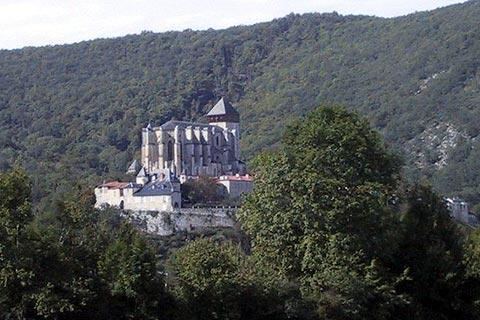Area 11.17 km² | Region Occitanie Canton Barbazan Population (2008) 257 Local time Tuesday 5:43 PM | |
 | ||
Weather 19°C, Wind N at 6 km/h, 38% Humidity Points of interest Saint‑Bertrand‑de‑Comminges Cathedral, Les Olivétains I, Les Olivétains II, Lugdunum Convenarum | ||
Saint-Bertrand-de-Comminges is a commune in the Haute-Garonne department in southwestern France. It is a member of the Les Plus Beaux Villages de France ("The Most Beautiful Villages of France") association.
Contents
Map of 31510 Saint-Bertrand-de-Comminges, France
History
In 72 B.C. the Roman General Pompey, while on the way back to Rome after a military campaign in Spain founded a Roman colony there. The goal was to defend the passage to the Aran Valley and the Iberian peninsula. The colony was named Lugdunum Convenarum and had reached around 30,000 people at its highest point. It is believed to have been the place of exile from 39 AD of Herod Antipas, with his wife Herodias, under Caligula's orders. In 408 the Vandals sacked the city and forced the peasantry to move to the citadel and in 585 the Burgundians, led by Guntram, entirely razed the site in the course of their pursuit of Gundoald. It would remain deserted for nearly five centuries.
In 1083 a knight related to the Counts of Toulouse, Bertrand de l'Isle-Jourdain, canon of Saint Augustine in Toulouse, was nominated bishop of Comminges. He ordered the construction of the cathedral and of the Romanesque cloister. The place became used by pilgrims as a stage on the route to Santiago de Compostela.
Bertrand de l'Isle was canonised and became known as Saint-Bertrand in the 13th century and Lugdunum Convenarum became known as Saint-Bertrand-de-Comminges. The term Comminges itself comes from the Latin word "Convenae", meaning "those who came together" at Pompey's new settlement.
In July 19, 2012, during the 99th edition of Tour de France, was one of the villages which cyclists passed by.
Sights
Aside of the former cathedral the village has a Romanesque basilica as well as Roman ruins. There is an archeological site close to the Cathedral in which it is possible to identify the remains of a Roman thermae and of a theatre.
The village itself is a medieval one, with several arches and vaults. It has several gates entering it; on the Cabirole Gate it is possible to read about the tax set by Louis XIV on fish. Another gate, the Majou Gate, is interesting in that it is the one pilgrims used. Following the ramparts it is possible to observe the Matacan Rock from which, according to the legend, Gondoald had been executed by Gunther.
Former cathedral
Entering the nave people will see three distinct architectural styles at the same time:
The narthex ends by two huge pillars with a circumference of no less than 11.45m. Over the northern and southern walls one can see the Romanesque arches, the floors are made of marble and include some tombs and sepulchres. The choir is also clearly Romanesque and offers an impressive view over the entire valley.
The Gothic part is built in the Meridional Gothic style. There is a single nave that is 55m long, 16m wide and 28m tall. Over the arrow arches there are "coat of arms" from the founding bishops. The stained glasses are impressive by their level of details, almost comparable to those of Auch.
The stalls within the choir were commissioned by Jean de Mauléon but because of the lack of documentation it is impossible to name the artist that made them. Although and by comparison with other stalls it is often considered it was the work of Nicolas Bachelier, or rather of his school which had been using artists from France, Spain and Italy. Most of the work had been done in oak and walnut, the choir seems cut off from the rest of the church contrasting so much with the Gothic and Romanesque parts.
The sixty-seven stalls represent characters from both the Old and the New Testaments, including scenes like: temptation, envy and lust.
The former cathedral has been listed as a UNESCO World Heritage Site as part of the World Heritage Sites of the Routes of Santiago de Compostela in France.
